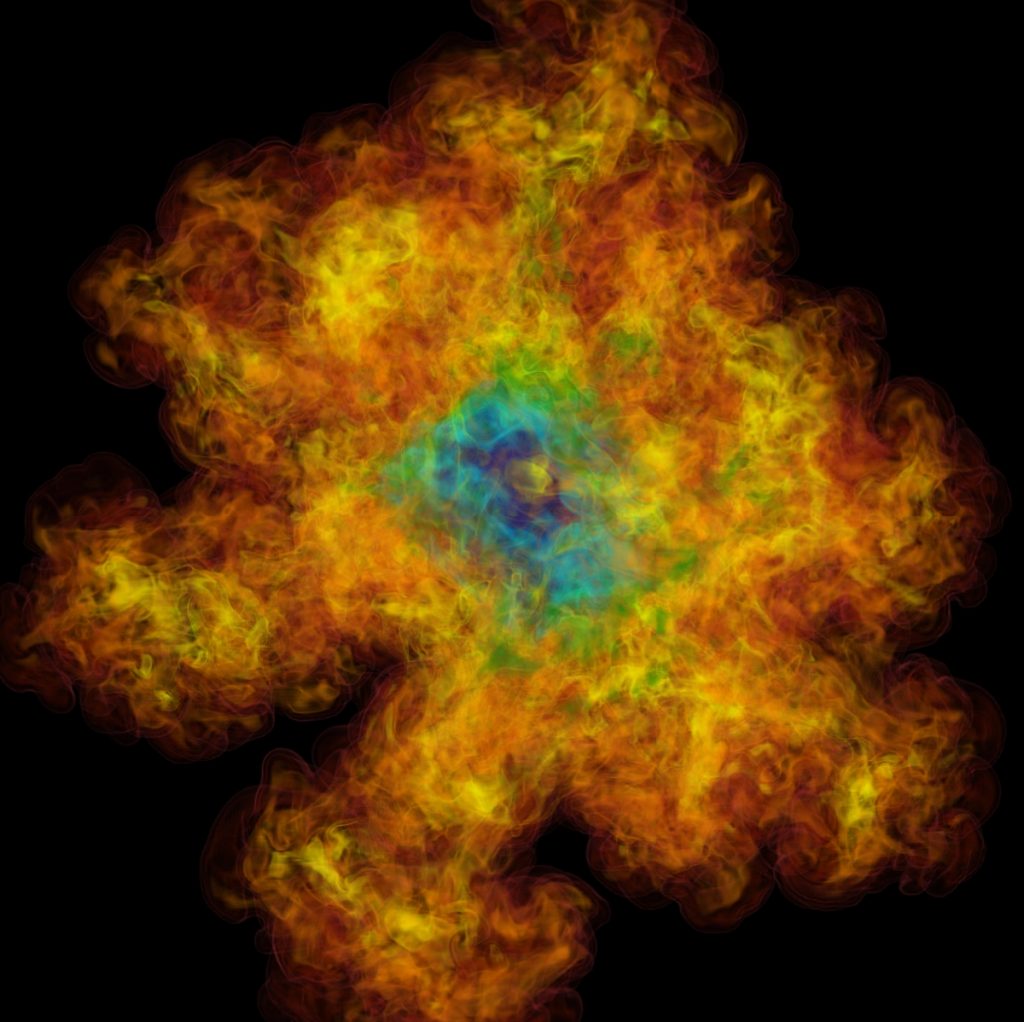An explosive result
Nuclear physicists from Finland, Denmark, and Germany succeeded to experimentally determine nuclear processes operating at conditions ten million times denser and 25 times hotter than the center of our Sun. A result of the measurement is that intermediate-mass stars are very likely to explode, and not, as assumed until now, collapse. This was confirmed with three-dimensional computer simulations by astrophysicists at the Heidelberg Institute for Theoretical Studies (HITS), Germany, and the Los Alamos National Laboratory, USA. The findings have been published in the scientific magazine Physical Review Letters.

Snapshot of a three-dimensional simulation: In contrast to previous belief, the star is more likely to be disrupted by a thermonuclear explosion than to collapse into a neutron star. Picture: Samuel Jones, LANL/HITS
Depending on their mass, stars take different evolutionary paths. Low-mass stars, such as our Sun, will eventually become white dwarfs. Massive stars, in contrast, terminate their lives in spectacular explosions known as supernovae, leaving behind either a neutron star or a black hole. But where is the dividing line between these two options? The fate intermediate-mass stars, which weigh 7 to 11 times as much as the Sun, has remained unclear. This is surprising since intermediate-mass stars are prevalent in the Galaxy.
The final fate of intermediate-mass stars depends on a tiny detail, namely, how readily electrons are captured on the isotope neon-20 in the stellar core. Depending on this electron capture rate, the star will be either disrupted in a thermonuclear explosion or it will collapse to form a neutron star. In 2014 theorists pointed out that the strongly suppressed and hence previously ignored and experimentally unknown transition between the ground states of neon-20 and fluorine-20 was the last piece of information needed to determine the electron capture rate at the astrophysical conditions reached in intermediate-mass stars. Now, an international collaboration of physicists has succeeded in obtaining the first accurate determination of this important rate through a combination of careful measurements of the beta-decay of fluorine-20 and theoretical calculations. The experiment took place under conditions far more peaceful than those found in stars, namely at the Accelerator Laboratory of the University of Jyväskylä, Finland. The measurements found a surprisingly strong transition between the ground states of neon-20 and fluorine-20 that leads to electron capture on neon-20 occurring at lower density than previously believed. What does this imply for the fate of the star? A detailed three-dimensional simulation performed by the Physics of Stellar Objects Group at the Heidelberg Institute for Theoretical Studies (HITS) and by scientists in the XCP division at Los Alamos National laboratory, USA, demonstrates that, in contrast to previous belief, it is more likely to be disrupted by a thermonuclear explosion than to collapse into a neutron star.
The new result is the last missing ingredient required to understand the nuclear processes that take place in the interior of the star during the last moments of its life. Since thermonuclear explosions eject much more material than those triggered by gravitational collapse, the results have implications for galactic chemical evolution. The ejected material is rich in titanium-50, chromium-54, and iron-60. Therefore, the unusual titanium and chromium isotopic ratios found in some meteorites, and the iron-60 discovered in deep-sea sediments could have been produced by an intermediate-mass star exploding in our galactic neighborhood in the distant (billions of years) and not so distant (millions of years) past.
In the light of these new findings the most probable fate of intermediate-mass stars seems to be a thermonuclear explosion, producing a subluminous Type Ia supernova and a special oxygen-neon-iron white dwarf. Detection or non-detection of such white dwarfs in the future would provide important insights into the explosion mechanism.
Reference:
O. Kirsebom et al., Discovery of an exceptionally strong beta-decay transition of 20F and implications for the fate of intermediate-mass stars, Physical Review Letters 123, 262701 – published 24 December 2019.
Viewpoint: “A Forbidden Transition Allowed for Stars”, by Carla Frohlich, in “Physics”, 24 December 2019.
Press Contact:
Dr. Peter Saueressig
Public Relations
Heidelberg Institute for Theoretical Studies (HITS)
Tel: +49-6221-533-245
peter.saueressig@h-its.org
https://www.h-its.org
Scientific Contact:
Prof. Dr. Friedrich Röpke
Group leader Physics of Stellar Objects (PSO)
Heidelberg Institute for Theoretical Studies (HITS)
Phone: +49-6221-533270
friedrich.roepke@h-its.org
About HITS
HITS, the Heidelberg Institute for Theoretical Studies, was established in 2010 by physicist and SAP co-founder Klaus Tschira (1940-2015) and the Klaus Tschira Foundation as a private, non-profit research institute. HITS conducts basic research in the natural, mathematical, and computer sciences. Major research directions include complex simulations across scales, making sense of data, and enabling science via computational research. Application areas range from molecular biology to astrophysics. An essential characteristic of the Institute is interdisciplinarity, implemented in numerous cross-group and cross-disciplinary projects. The base funding of HITS is provided by the Klaus Tschira Foundation.